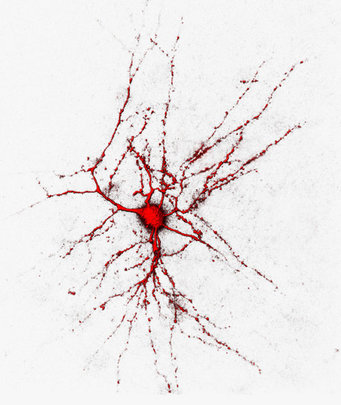Chloride channels render nerve cells more excitable
Scientists discover how nerve cells may influence their own activity
Nerve cells communicate with each other by means of electrical impulses. To create such an impulse, the cells exchange charged ions with their environment. However, the role played by the ever-present chloride channels remained obscure, although some theories predicted a relation between the chloride channel ClC-2 and epilepsy. Scientists at the Max Planck Institute of Neurobiology in Martinsried were now able to confirm a number of assumptions about the ClC-2 channel and could at last explain why the anticipated epileptic seizures do not occur when nerve cells lack the ClC-2 channels in mice. The results also provide a completely new understanding of how nerve cells may actively influence the exchange of information. (The Journal of Neuroscience online publication, April 1st, 2010)

The cell membranes of nerve cells, like those of all other cell types in the body, are perforated by so-called chloride channels. These permit the exchange of negatively charged chloride ions between the cell and its environment. Yet scientists could so far only speculate about the purpose of this exchange. According to one very prevalent theory, the excitability of nerve cells decreases when they lose chloride ions through these channels. Or, to put it the other way round, the lack of chloride channels would cause nerve cells to become overexcited. This in turn should lead to an increased rate of epileptic seizures. However, mice whose nerve cells lack chloride channels due to a genetic mutation were found no more susceptible to epilepsy than healthy animals. And so the function of the ClC-2 and of other chloride channels remained obscure.
Scientists at the Max Planck Institute of Neurobiology have now tracked down a number of the ClC-2 channel's functions. This constitutes the first tangible proof of the circumstances under which chloride ions can escape from nerve cells through the ClC-2 channels. In the case that nerve cells were lacking the ClC-2 channels due to a mutation in the channel's gene, the concentration of chloride inside the cells did indeed increase considerably.
The Max Planck scientists were also the first to successfully prove the third hypothesis - that the nerve cells of mice with a genetic ClC-2 deficiency were much easier to excite than nerve cells in a healthy brain. Earlier assumptions therefore turned out to be correct. Then why did animals lacking the ClC-2 channels show no sign of epilepsy?
The answer to this question was not only plausible, but also straightforward. In addition to having cells that transmit information to their neighbouring cells, the nervous system contains a second group of nerve cells. These cells inhibit the exchange of information between its neighbours. In animals with a ClC-2 genetic defect, these inhibitory nerve cells also forfeit their chloride channels, and therefore become more excitable. Thus, excitatory and inhibitory cells become more excitable. "Although the whole system becomes more sensitive, at the end of the day the balance between the cells is maintained", explains Valentin Stein, leader of the study. And so the anticipated connection between genetic defect and epilepsy is not expressed. However, the lack of ClC-2 channels throws the nervous system into an unnaturally excited state. The scientists therefore speculate that although a defective ClC-2 gene does not cause epilepsy in itself, it may increase the risk of contracting epilepsy if other factors are present.
"We reckon, however, that we have come across something even more exciting", says Valentin Stein. The neurobiologist is referring to the discovery that nerve cells can theoretically use the ClC-2 channels to influence their own excitability. "If a nerve cell can control its own excitability by opening or closing its ClC-2 channels, then it could basically have a say in whether or not it transmits information to its neighbour." This possibility adds a whole new dimension to brain research. When and how nerve cells transmit information is one of the most fundamental functions of the brain and forms the basis of our ability to think. And so it comes as no surprise that the scientists can hardly wait to get on with the next stage of their investigations into this discovery.
